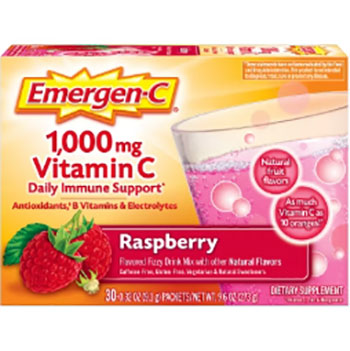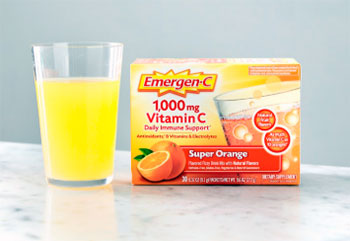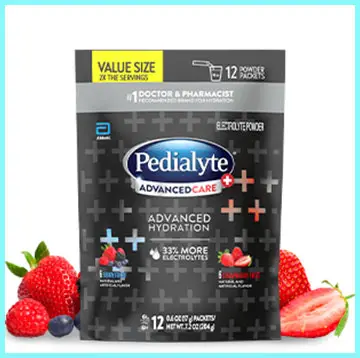When I’m feeling less than my best—whether it’s the scratchy throat that signals a looming cold or the foggy-headed misery of a bad hangover—I find myself staring into my cabinet at two completely different solutions: a bright orange packet of Emergen-C and a clinical-looking bottle of Pedialyte.
They both promise to make me feel better, but they are worlds apart. My goal here is to break down exactly what each one does, why they shouldn’t be used interchangeably, and when I personally reach for one over the other.
A Brief Comparison Table
| Feature | Emergen-C | Pedialyte |
| Primary Use | Vitamin & Immune Support | Medical-Grade Rehydration |
| Key Ingredients | High-dose Vitamin C, B Vitamins, Zinc | Sodium, Potassium, Chloride, Glucose (Dextrose) |
| Electrolytes | Very Low (some sodium/potassium) | Very High (Balanced Oral Rehydration Solution) |
| Best For… | Daily wellness boost, feeling a cold coming on, minor energy slump | Vomiting, diarrhea, intense dehydration, hangover recovery |
| Sugar Content | Varies (0g to ~6g per packet) | Varies (Contains sugar/dextrose for sodium transport) |
| Form Factors | Powder packets | Liquid bottles, powder packets, freezer pops |
My Experience With Emergen-C
For me, Emergen-C is all about the ritual. It’s a proactive measure. When I feel that first tickle in my throat, or when my cubicle mate won’t stop sneezing, I grab a Super Orange packet. It’s my pre-flight armor; I’ll drink one at the gate before boarding a long flight, convincing myself the recycled air has met its match.

The experience itself is part of the appeal.
Tearing open the packet, dumping the bright orange powder into a glass of water, and watching it fizz feels like I’m doing something.
It’s a sensory signal.
The citrus smell and the fizzy taste are a psychological boost as much as a physical one.
It’s what I call a “placebo-plus.”
I know it’s not a miracle cure, but it’s loaded with vitamins that my body can use, and it makes me feel like I’m actively taking care of myself.
It’s a warm, fizzy blanket for my immune system, or at least that’s how I like to think of it. It’s my go-to for “I feel a little off,” not for “I am down for the count.”
Read More: My Thoughts On Boiron Homeopathic Medicine
Pros Of Emergen-C
- The Vitamin C Powerhouse: This is the product’s entire claim to fame, and it’s a big one. Each packet delivers 1,000 mg of Vitamin C, which is well over 1,000% of the daily recommended value.1 As an antioxidant, Vitamin C is a critical component for fighting free radicals and supporting overall cellular health.2 When I’m feeling run-down, this massive dose feels like calling in the cavalry for my immune system. While science is debated on whether it can prevent a cold, some studies suggest it might shorten the duration of one. For me, it’s less about prevention and more about support. When my body is stressed or I haven’t been eating well, I know my immune system is working overtime, and giving it this foundational vitamin feels like a necessary support. It’s also vital for collagen production, so I sometimes joke it’s my “skin-brightening” sick drink.
- Energy-Boosting B Vitamins: This is a pro that often gets overlooked. Emergen-C isn’t just a one-trick pony with Vitamin C. It’s packed with B vitamins—B1, B2, B3, B6, and B12.3 These are the “energy” vitamins, not in the way caffeine provides a synthetic jolt, but in a more fundamental way. B vitamins are essential coenzymes in metabolic processes; they are what help my body convert the food I eat into usable energy.4 When I’m feeling sluggish, that 3 PM slump at work, an Emergen-C can provide a noticeable, non-jittery lift. It’s like giving my cellular engines a proper tune-up so they can run more efficiently. This makes it a great alternative to a sugary energy drink when I just need to get through the afternoon.
- Impressive Flavor Variety And Drinkability: Let’s be honest: if a wellness product tastes awful, I’m not going to use it consistently. Emergen-C has mastered this. Super Orange is the classic, but they have Raspberry, Tangerine, Acai Berry, and dozens of other variations, including seasonal flavors. They’ve made taking vitamins feel like a treat. It’s fizzy, slightly sweet, and genuinely pleasant to drink. This high “drinkability” factor is crucial. It means I’m more likely to take it proactively, rather than waiting until I’m already sick. It also encourages me to drink a full glass of water, which is a hydration benefit in itself, even if the packet isn’t an “electrolyte” drink.
- Ultimate Convenience And Portability: This is a huge practical win. The product is sold in single-serve, flat-pack paper-foil packets.5 I have them stuffed everywhere: my desk drawer at work, my gym bag, my car’s glove compartment, and my travel carry-on. They weigh practically nothing and are instantly ready with just a bottle or glass of water. This accessibility means I’m never without it. If I suddenly feel that “uh-oh” moment at work, I don’t have to wait until I get home. I can have my vitamin boost right then and there. This convenience is a major reason it has become such a staple in my wellness toolkit.
Cons Of Emergen-C

- Misleading Hydration Positioning: This is my biggest complaint and the source of all the confusion. Because it’s a powder you mix with water and has some electrolytes (like sodium and potassium), people—myself included, at first—assume it’s a hydration drink. It is not. The electrolyte levels are a tiny fraction of what’s needed for true rehydration. It has about 75 mg of potassium and 65 mg of sodium. Pedialyte, by contrast, has 780 mg of potassium and 1,690 mg of sodium in a liter (or adjusted for a similar serving). If I’m genuinely dehydrated from a workout, a stomach bug, or a hangover, reaching for an Emergen-C is like using a water pistol to put out a house fire. It’s the wrong tool, and this misconception can be problematic if someone is relying on it for a serious fluid-loss situation.
- The Sugar Content: To make all those vitamins palatable, many of the most popular Emergen-C formulas contain added sugars.6 The classic Super Orange has about 5-6 grams of sugar per packet. While this isn’t as high as a can of soda (which has around 39 grams), it’s still added sugar that I don’t really need, especially if I’m taking it daily. It’s sugar for the sake of flavor. For people who are diabetic, pre-diabetic, or just trying to cut down on sugar intake, this is a significant drawback. It positions the product more as a “tasty drink” and less as a pure health supplement. I often find myself annoyed that I have to consume sugar just to get my vitamins.
- The Artificial Sweetener Alternative: “Great,” I thought, “I’ll just buy the sugar-free version!” But that comes with its own con. To achieve that sweetness without sugar, the sugar-free formulas often rely on artificial sweeteners like sucralose or aspartame. There’s a large (and growing) group of consumers who are actively trying to avoid these ingredients, citing concerns about gut health, artificial tastes, or other potential long-term effects. This puts me in a bind: do I choose the unnecessary sugar, or do I choose the artificial chemicals? It feels like a trade-off I shouldn’t have to make for a “health” product.
- Potential For “Expensive Urine”: This is the classic argument against any high-dose vitamin supplement. Vitamin C and B vitamins are water-soluble.7 This means my body can’t store them for later. It will take what it can absorb and process at that moment, and absolutely everything else is simply… flushed out. When I take 1,000 mg of Vitamin C, my body is likely only absorbing a fraction of that, especially if I’m not deficient. The rest is excreted, leading to the infamous bright yellow, vitamin-enriched urine. Am I just paying for the privilege of coloring my toilet water? It’s a valid question. It makes me wonder if I’d be better off just eating an orange and a handful of spinach.
- Gastrointestinal Discomfort: That 1,000 mg dose of ascorbic acid (Vitamin C) is potent. For me, and I know for many others, taking that much acidic vitamin C on an empty stomach can be… unpleasant. It can cause a bit of acid reflux, a sour stomach, or just a general feeling of mild nausea. It’s not a gentle, soothing drink. It’s a fizzy acid bomb. This means I have to be careful when I take it, preferably with some food, which defeats the convenience of just grabbing it whenever I feel a cold coming on. It’s a small con, but it’s a definite friction point in my experience.
My Experience With Pedialyte

My relationship with Pedialyte is completely different.
It’s not proactive; it’s reactive.
I don’t drink Pedialyte hoping to prevent anything. I drink Pedialyte when the damage is already done.
My most vivid memory is after a nasty 24-hour stomach bug. I was completely wiped out, dizzy, and couldn’t even keep water down for long.
My wife brought home a bottle of “AdvancedCare Plus” Pedialyte, and I grimaced.
I thought it was just for kids. The first sip was… weird.
It’s not a “tasty” drink. It has a distinct, slightly salty, slightly thick mouthfeel. But here’s the thing: within an hour, I felt human again. The fog in my head started to lift.
The dizziness subsided. It was like watching a wilted plant come back to life after being watered. I could feel my body absorbing it. Now, it’s my nuclear option for hangovers or any time I’m actually sick. It’s not my friend, it’s my medic.
Pros Of Pedialyte
- The Gold Standard For Rehydration: This is Pedialyte’s entire purpose, and it excels. It’s not just “water with stuff.” It’s a scientifically-formulated Oral Rehydration Solution (ORS). Its power lies in the “sodium-glucose cotransporter.” The small amount of sugar (dextrose) in the formula isn’t just for flavor; it’s a transport mechanism. This specific sugar molecule actively pulls sodium across the intestinal wall into the bloodstream, and water follows the sodium. This makes it vastly more effective at rehydrating the body than water alone, or even a typical sports drink. When I’m severely dehydrated, I can literally feel this working. It’s a medical-grade solution to a medical-grade problem.
- Medically-Endorsed For Sickness: This is the drink doctors and pediatricians recommend when a child (or adult) has vomiting or diarrhea. Why? Because when you’re losing fluids that rapidly, you’re not just losing water. You’re losing critical electrolytes: sodium, potassium, and chloride. Drinking plain water in that state can actually make things worse by further diluting the electrolytes you have left, a dangerous condition called hyponatremia. Pedialyte is specifically designed to replace both the fluids and the precise balance of salts lost during illness.8 It’s the “at-home IV drip,” and having it on hand gives me incredible peace of mind when someone in the house is sick.
- The Ultimate Hangover Relief: This is the famous “off-label” use that has made it a cult favorite among adults.9 Alcohol is a diuretic, meaning it makes you urinate more, leading to dehydration.10 That pounding headache, dry mouth, and sense of dread? That’s largely dehydration and the resulting electrolyte imbalance. A sports drink helps a little, but Pedialyte is on another level. I’ll drink half a bottle before bed after a long night out and the other half when I wake up. It directly and efficiently replenishes exactly what the alcohol stripped away. It’s not a cure (only time can cure a hangover), but it is the single most effective relief I’ve ever found.
- Variety In Formats For All Situations: Pedialyte understands its market. The classic one-liter bottle is the workhorse for a bad sick day at home. But they’ve adapted. They now make powder packets, just like Emergen-C, which are perfect for travel.11 I can throw a few in my suitcase in case of traveler’s sickness or a vacation hangover. The most genius format, in my opinion, is the freezer pops. When a child (or a nauseous adult) is struggling to keep liquids down, a Pedialyte freezer pop is a game-changer. It’s small, it’s cold (which is soothing), and it delivers the same rehydration solution slowly, making it much easier to tolerate.
Cons Of Pedialyte
- The Taste And Mouthfeel: This is the number one barrier. Let’s not sugarcoat it: Pedialyte does not taste good. It can’t taste as good as a soda or Emergen-C and still do its job. To be an effective ORS, it must contain a significant amount of sodium. That saltiness comes through, even in the “Fruit Punch” or “Berry” flavors. It’s a medicinal taste that you tolerate, not enjoy. The “AdvancedCare” versions also have prebiotics, which can give them a slightly thicker, almost syrupy mouthfeel.12 It’s not refreshing. It’s a functional beverage in the truest sense, and the function absolutely obliterates any hope of a “delicious” flavor.
- The Significant Price Point: This stuff is not cheap. A single one-liter bottle of Pedialyte can cost as much as a 30-packet box of Emergen-C. It’s priced as a medical-adjacent product, not a casual beverage. This high cost can be a real con, especially if you’re using it for something like hangovers, where it feels like a “luxury” purchase. When I’m sick, I’ll pay anything to feel better, so I don’t care. But as a preventative or a regular post-workout drink, the cost is absolutely prohibitive. It’s in a different price category than sports drinks or vitamin powders.
- High Sodium And Sugar (For A Casual Drink): This is the flip side of its primary pro. The sugar and sodium that make it a miracle when you’re sick make it a terrible choice for when you’re not. If I’m just sitting at my desk feeling fine and I drink a Pedialyte, I’m flooding my system with sugar and a ton of sodium that my body doesn’t need. A one-liter bottle can have over 1,600 mg of sodium. That’s more than 70% of the recommended daily intake for a healthy adult. It is absolutely not a wellness drink, a daily hydrator, or a sports drink for a light workout. Using it casually is unhealthy.
- The “Sick” Stigma: This is a social and psychological con. Walking into the office on a Monday morning clutching a one-liter bottle of “Pedialyte AdvancedCare” is… a statement. It’s not subtle. It’s brightly colored, has a medicinal-looking label, and is universally associated with one of three things: a sick baby, a stomach bug, or a very rough weekend. It’s not a “lifestyle” brand. It’s a recovery product, and I’m not always in the mood to broadcast that I’m in recovery mode. The powder packets have helped with this, as they’re more discreet, but the brand’s core identity is still very much “I am unwell.”
Also Read: My Thoughts On Country Farms Immune Defense
Frequently Asked Questions (FAQ)
No. It contains very low levels of electrolytes, not nearly enough to treat dehydration. It’s a vitamin supplement, not a rehydration drink.
For medical rehydration (like from sickness), Pedialyte is the “healthiest” because it’s scientifically formulated for that purpose. For daily health, the best “drink” is water.
You must ask your doctor. The high doses of Vitamin C and other vitamins may exceed recommended prenatal guidelines.
It doesn’t cure sickness. The high dose of Vitamin C may slightly shorten the duration of a cold, but the main benefit is hydration (from the water) and a vitamin boost.
Conclusion
So, after all this, what’s my final verdict? It’s simple: you’ve been trying to compare a wrench to a hammer. They both live in the toolbox, but you’d never use one for the other’s job.
Emergen-C is my “shield.” I use it proactively. It’s my fizzy, orange-flavored ritual when I feel a cold tickle, or when I’m about to get on a plane. It’s a vitamin and psychological boost to help my body stay well.
Pedialyte is my “medic.” I use it reactively. It’s my “break glass in case of emergency” solution when I am already unwell—sick, badly hungover, or dangerously dehydrated. It’s a scientific rescue tool.
The mistake we all make is thinking they’re in the same category. They’re not. The next time you’re feeling run down, ask yourself a simple question: “Do I need a shield, or do I need a medic?”
Your answer will tell you exactly which box to reach for.
